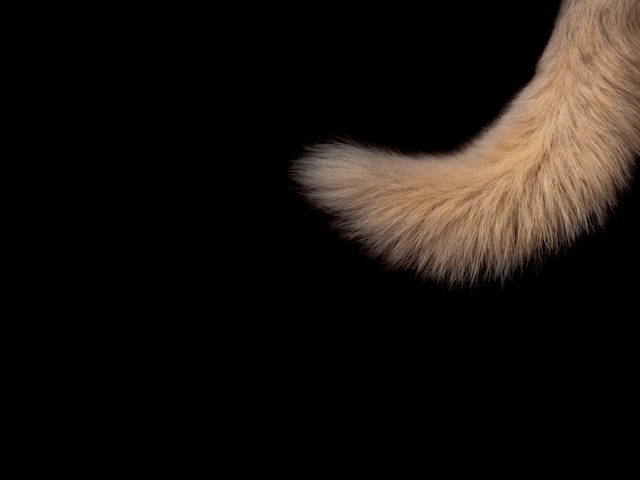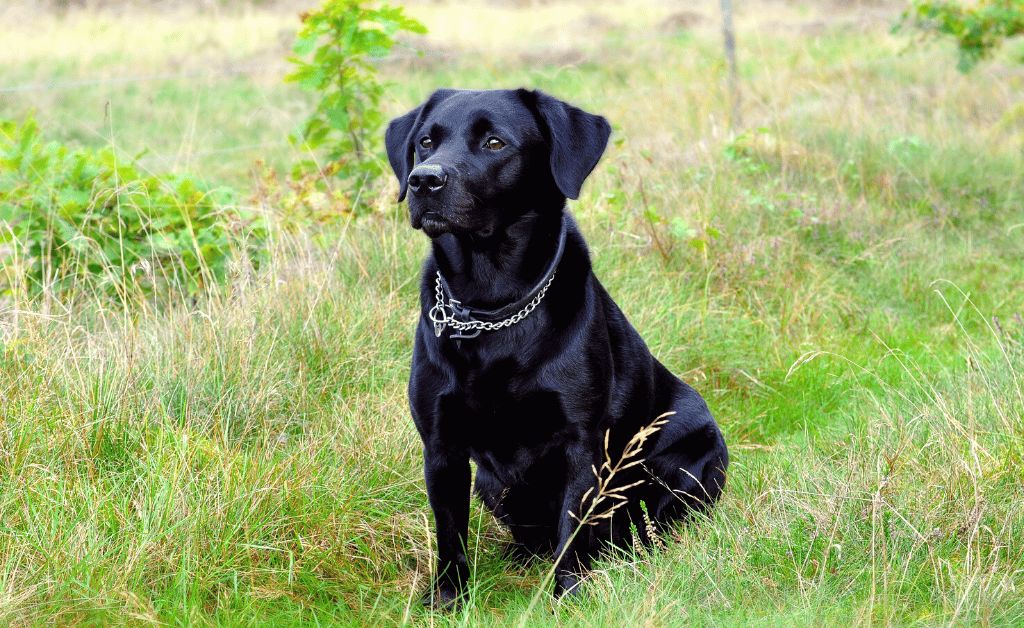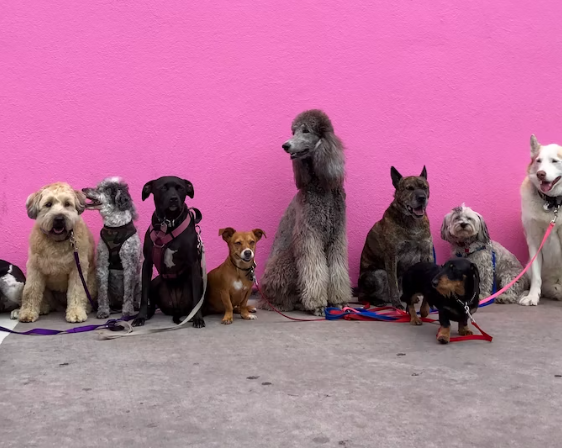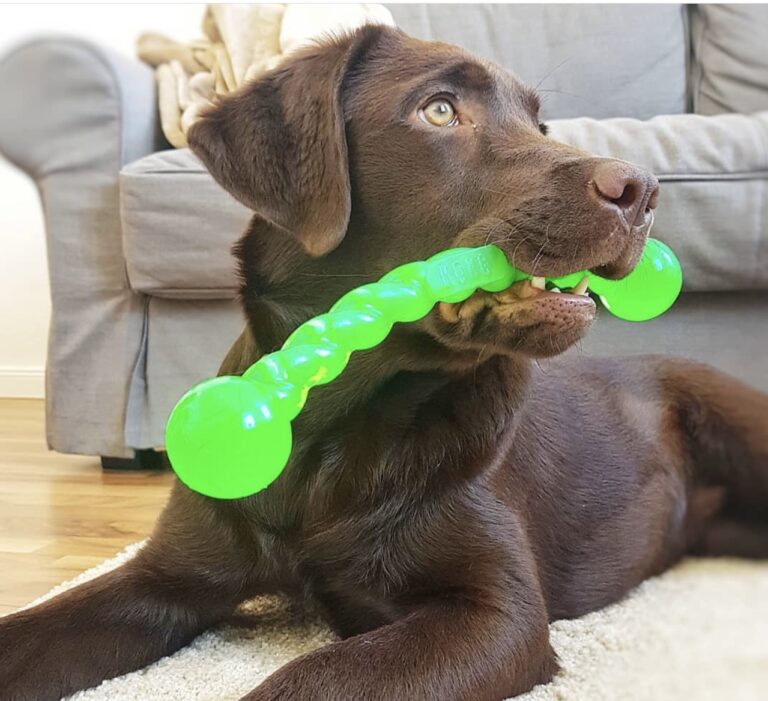Unveiling the Mystery Behind Why Do Labradors Wag Their Tails
Labradors are one of the most beloved dog breeds worldwide, known for their friendly nature and wagging tails that can light up any room. But have you ever wondered why Labradors wag their tails with such enthusiasm? It turns out there’s more to it than meets the eye. In this blog, we’ll explore the fascinating reasons why do Labradors wag their tails. So, are you ready? Without further ado, let’s dive in!
Description Of The Tail Structure And Muscles In Labradors

Understanding the tail’s anatomy and musculature enhances our appreciation of these remarkable dogs and their unique capabilities. Let’s dive in.
🟦 Tail Structure
The tail of a Labrador is an extension of its spinal column, moderately long and thick at the base, gradually tapering towards the end. Covered in dense fur that matches the dog’s coat color, the tail consists of a series of individual bones called vertebrae. These vertebrae, connected by flexible joints, provide a wide range of movement and positions for the tail. The last few vertebrae, known as the caudal vertebrae, are more mobile than the rest, allowing for increased flexibility.
🟦 Muscles Involved
Several muscles work in harmony to control the movement and positioning of a Labrador’s tail. Let’s explore the key muscles involved:
>>Caudal Epaxial Muscles
The caudal epaxial muscles run along the length of the tail, providing support and stability. These muscles assist in maintaining the tail’s posture and play a crucial role in lateral movements, allowing the tail to sway from side to side. They contribute to the overall coordination and balance of Labradors.
>>Caudal Flexor Muscles
Situated on the underside of the tail, the caudal flexor muscles are responsible for flexion or bending of the tail. These muscles allow the tail to curl and wrap around the body, a characteristic often seen when Labradors are happy or excited. The caudal flexor muscles play a role in conveying emotions through tail movements.
>>Caudal Extensor Muscles
The caudal extensor muscles are located on the top side of the tail and are responsible for extending the tail and straightening it. These muscles allow Labradors to hold their tails upright or outstretched. They contribute to movements such as wagging, expressing happiness, or alertness.
>>Caudal Lateral Muscles
Found on the sides of the tail, the caudal lateral muscles aid in lateral movements. They allow the tail to sway from side to side, providing additional balance while the Labrador is walking or swimming. These muscles work in coordination with other muscles to ensure smooth and controlled movement.
The tail structure and muscles in Labradors are a remarkable testament to their adaptability and communication abilities. Labradors’ strong tails, supported by well-coordinated muscles, provide them with balance, swimming prowess, and an expressive means of communication. By appreciating the intricacies of the tail’s anatomy, we gain a deeper understanding of these beloved dogs. Observing their tail movements and positions enriches our connection with Labradors, enabling us to better respond to their needs and emotions.
Labradors Wag Their Tails As A Form Of Communication
To determine if a Labrador is wagging its tail as a means of communication, you can consider the following factors:
🟦 Context
Consider the overall situation and environment in which the tail wagging occurs. Labradors are social animals and use tail wagging to communicate their emotions and intentions. If the Labrador is in a positive and relaxed setting or engaging in friendly interactions with people or other animals, it’s more likely that the tail wagging is a form of communication. For example, if a Labrador is happily wagging its tail when greeting a familiar person or playing with other dogs, it’s a positive indication of communication.
🟦 Body language
Pay attention to Labrador’s overall body language to get a better understanding of its communication. A Labrador wagging its tail in conjunction with a relaxed body posture, loose movements, and a happy expression is a good indication that it is communicating in a friendly and positive manner. Signs of a relaxed body posture include a loose stance, soft eyes, a relaxed mouth, and a wiggly or loose body. On the other hand, if the Labrador’s body is tense, with raised hackles, a stiff posture, or a closed mouth, it may be communicating stress or discomfort, even if its tail is wagging.
🟦 Speed and intensity
The speed and intensity of the tail wagging can convey different messages. A fast and vigorous wag often indicates excitement and happiness. For example, when a Labrador is excited to see its owner or is anticipating something enjoyable like a walk or playtime, it may wag its tail rapidly. On the other hand, a slower and more gentle wag may suggest a calmer and more relaxed state. Additionally, a wide range of motion in the wag, where the tail moves in a large arc, is often associated with a positive and friendly mood.
🟦 Direction
The direction in which the tail is wagging can also provide insights into the Labrador’s emotional state, although individual dogs may vary. Studies have suggested that a rightward wag is associated with positive emotions, while a leftward wag may indicate negative emotions or stress. However, it’s important to note that this is not a foolproof indicator and should be considered alongside other cues. Monitoring the Labrador’s overall body language and behavior will help provide a more accurate understanding of its emotions.
🟦 Tail position and movement
The position and movement of the tail can add additional meaning to the Labrador’s communication. A high, raised tail often signifies confidence and alertness. It can be seen when a Labrador is excited, curious, or on alert. Conversely, a low or tucked tail may indicate fear, anxiety, or submissiveness. A tucked tail is often a sign that the dog is feeling fearful or insecure. Additionally, a wide, sweeping wag that involves the entire rear end typically suggests happiness and enthusiasm. A stiff or rigid wag, on the other hand, may signal tension or uncertainty.
🟦 Consistency with other cues
Tail wagging should be considered in conjunction with other body language cues to get a complete understanding of the Labrador’s communication. Pay attention to the position of the ears, facial expressions, vocalizations, and overall behavior. The Labrador’s eyes, mouth, and ear position can provide important information about its emotional state. For example, relaxed eyes and a slightly open mouth usually indicate a friendly and relaxed Labrador, while a tense expression or bared teeth may indicate aggression or discomfort.
Remember that each Labrador is an individual, and their communication styles may vary. It’s essential to observe and understand your specific Labrador’s unique body language and tail-wagging patterns, as these can differ from dog to dog. If you’re uncertain about your Labrador’s behavior or communication, consulting with a professional dog trainer or behaviorist can provide further guidance and help you interpret your Labrador’s cues accurately.
Labradors Wag Their Tails Due To Emotional Triggers
Labradors, like other dogs, can wag their tails in response to emotional triggers. Emotional triggers are stimuli or situations that evoke specific emotions or responses in an individual. When a Labrador encounters an emotional trigger, it may respond by wagging its tail in a particular way. Here are some examples:
🟦 Excitement
Labradors often wag their tails vigorously when they are excited. Emotional triggers that can cause excitement include seeing their favorite toys, anticipating playtime or outdoor activities, or encountering familiar people or other dogs. The tail wagging in this case is usually rapid, with a wide range of motion, and accompanied by an overall energetic and happy body language. Labradors may also exhibit jumping, bouncing, or even spinning along with the tail wagging when they are highly excited.
🟦 Happiness and joy
Labradors express their happiness and joy through tail wagging. Emotional triggers for happiness can be varied, such as receiving affection, being praised or rewarded, or engaging in activities they enjoy. When Labradors are genuinely happy, their tail wagging is usually pronounced, with a wide, sweeping motion that involves the entire rear end. They may also display a relaxed body posture, a bright expression, and may sometimes emit soft vocalizations or even bark playfully.
🟦 Curiosity
Labradors may wag their tails when they encounter something new or interesting. Tail wagging in response to curiosity is often slower and more deliberate compared to other contexts. It may be accompanied by a slightly cautious body posture, with the Labrador leaning forward or approaching the object or situation of interest. The tail wagging signifies the Labrador’s curiosity and eagerness to explore further, and it can serve as an invitation for interaction or investigation.
🟦 Friendliness and social interaction
Labradors are known for their friendly nature and wag their tails as a way to communicate their approachability during social interactions. When meeting new people or other dogs, Labradors may wag their tails gently and steadily, indicating their positive intent and willingness to engage. The tail wagging is often accompanied by relaxed body language, such as a loose stance, a relaxed face, and soft eyes. Labradors may also exhibit other signs of friendliness, such as a wiggly body or even leaning against the person or dog they are interacting with.
🟦 Stress or anxiety
In some cases, Labradors may wag their tails when experiencing stress or anxiety. Emotional triggers that cause stress or anxiety can vary among dogs and may include situations such as being in a crowded or unfamiliar environment, encountering aggressive or intimidating dogs, or experiencing loud noises. When a Labrador is anxious or stressed, its tail wagging may be more subtle and less pronounced compared to positive emotions. The wag may be slower, shorter in range, and accompanied by other signs of stress, such as a tense body posture, a lowered head, panting, or lip licking. It’s important to note that tail wagging alone should not be taken as an indication of a Labrador’s overall emotional state in such situations, as it needs to be considered alongside other body language cues.
Labrador’s unique body language and tail-wagging cues in different situations to accurately interpret their emotions. If you’re unsure about your Labrador’s behavior or need further guidance, consulting with a professional dog trainer or behaviorist is always recommended.
Labradors Wag Their Tails Due To Environmental Stress
Labradors may also wag their tails in response to environmental stress. Environmental stress refers to situations or stimuli in the Labrador’s surroundings that can cause anxiety, fear, or discomfort. While tail wagging is commonly associated with positive emotions, it can also occur in stressful situations. Here’s an expanded explanation:
🟦 Submissive tail wagging
Labradors may wag their tails as a submissive gesture when they are feeling stressed or anxious. In this case, the tail wagging is typically low and slow, and the Labrador may exhibit other signs of submission, such as a lowered body posture, tucked tail, averted gaze, and flattened ears. This type of tail wagging may occur when a Labrador encounters a dominant dog or is in a potentially threatening situation, signaling its submission and attempt to appease.
🟦 Tail wagging with tension
When a Labrador is experiencing environmental stress, its tail wagging may still occur, but with noticeable tension. The wagging may be faster or more erratic than usual, accompanied by a tense body posture, raised hackles (the hair along the back), and a generally alert and wary expression. This type of tail wagging suggests that the Labrador is feeling on edge or uncomfortable in its environment.
🟦 Tail tucked between the legs
In some cases of environmental stress, Labradors may tuck their tails tightly between their hind legs. This is a clear sign that the dog is feeling fearful, threatened, or overwhelmed by the environment. The tucked tail position helps protect their vulnerable rear end and is often accompanied by other stress-related behaviors like trembling, panting, or attempting to hide or escape.
🟦 Context and body language
When evaluating tail wagging as a response to environmental stress, it’s important to consider the overall context and the Labrador’s body language. Look for other signs of stress or anxiety, such as panting, drooling, pacing, avoidance behavior, or excessive vocalizations. Pay attention to the Labrador’s eyes, facial expression, and posture to get a better understanding of its emotional state.
It’s crucial to note that tail wagging alone should not be relied upon as the sole indicator of a Labrador’s emotional state or well-being, particularly in cases of environmental stress. It should be considered alongside other body language cues and the Labrador’s overall behavior. If you suspect your Labrador is experiencing stress or anxiety in its environment, it’s important to identify and address the underlying causes and consult with a professional, such as a veterinarian or a certified dog behaviorist, to provide appropriate guidance and support for your Labrador.
Final Words
In conclusion, Labradors’ tails are a window into their emotions and a source of joy for dog lovers everywhere. Whether they’re expressing excitement, happiness, or even apprehension, their tails provide valuable insights into their state of mind. By understanding why Labradors wag their tails, we gain a deeper appreciation for these incredible creatures and the bond they share with their human companions. So next time you see a Labrador wagging its tail, remember that there’s a story behind it, and it’s one that speaks volumes about their affectionate and loyal nature.
To know more about Labradors, just click here!








